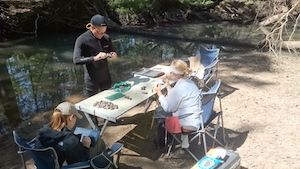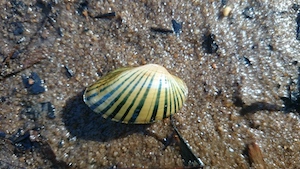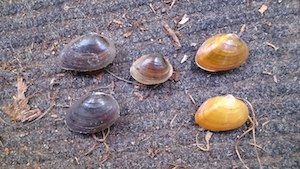Let’s talk about mussels and no, not the things you flex! Let’s talk about those shelled creatures that live in the water and play a major part in indicating water quality and stream health.
Why are we studying mussels?
The Apalachicola-Chattahoochee-Flint (ACF) River Basin of Alabama, Florida, and Georgia is home to several imperiled species of freshwater mussels. This long-term monitoring program will help figure out the instream flow needs of these unique animals. Ultimately, this will help biologists manage water resources in the Lower Flint River and ACF to help them survive and reproduce to ensure future populations of the at-risk species.
How do you even survey for these?
Like every field season, 2018 will be no different. Surveying consists of several weeks of donning masks, snorkels, and maybe even wetsuits to trek around the swamps and streams of southwest Georgia while trying to avoid cottonmouths and alligators. Staff will visit 5 streams that have been visited as many as 40 times over the past 14 years. Their goal: to collect as many mussels as possible.
Wait. How are they collected?
Simple! With your hands. Each crew member lines up and snorkels up the creek carefully running their fingers through the sand, gravel and into root wads. This isn’t for the faint of heart. As they try to grab any mussels they encounter, they also have to cross their fingers that nothing grabs them back. Once collected each mussel is identified, tagged with a small plastic oval shaped tag with a number, measured, and put back in the stream bottom.
What do these tags tell us?
The plastic tags on their shells help biologists assess how stream flow conditions are affecting these beleaguered bivalves. The data collected will be added to a database that will tell the story of mussel populations in each stream. It’s a modern day coming of age drama fit for the silver screen with a plot of survival, love, running from monsters (predators), returning home, natural disaster, and murder (or dinner depending on which way you look at it!).
The star-studded cast includes the beautiful and talented Shinyrayed Pocketbook, the polygamous Oval Pigtoe, and the mesmerizing Gulf Moccasinshell with a supporting cast consisting of the little known Iridescent Liliput, scenes with the Little Spectaclecase, all looking for the pot of gold at the end of a Southern Rainbow. Yes, mussels have some colorful names that you can do corny stuff with!
So, why is this important?
Each year of sampling closes another chapter of their stories with several highs and lows along the way. This book has lots of chapters. The 2018 field season marks the fourteenth, eleventh, and eighth years of sampling for three of the streams. The highs and lows refer to stream flows which are used to examine if individual animals lived, moved, were in hiding, or were born into the population between years. There’s also a strong possibility that they were ready and waiting to be picked up but our crews missed them, a term we call incomplete detection. For example, a lone individual collected in 2005 evaded recapture every year until the 2017 survey. We don’t know how old it was when it was first tagged but we know it was at least 12 years older when we captured it last year. All of this information is collected in the stream and brought back to the office to begin clipping the storylines together to see how it ends. This is where the real work begins. Through all of these years, 10,826 total live mussels have been collected, tagged, released, and entered into our database.
When you consider all of these combinations of animals and occasions, we have over 108,000 data points to use in finding the answers three big questions:
- What flows do the mussels survive best?

- When are the flows too high or too low to go on a date?
- Were biologists efficient when sampling for them and if not, why?
The answers to these questions will help guide our understanding of the conservation needs of freshwater mussels.
While we realize mussels will probably never win an Academy Award, we hope sharing this little story offers some pearls of wisdom about this frequently forgotten fauna.




















